莫奈名画生平英文介绍
- 格式:ppt
- 大小:2.42 MB
- 文档页数:11
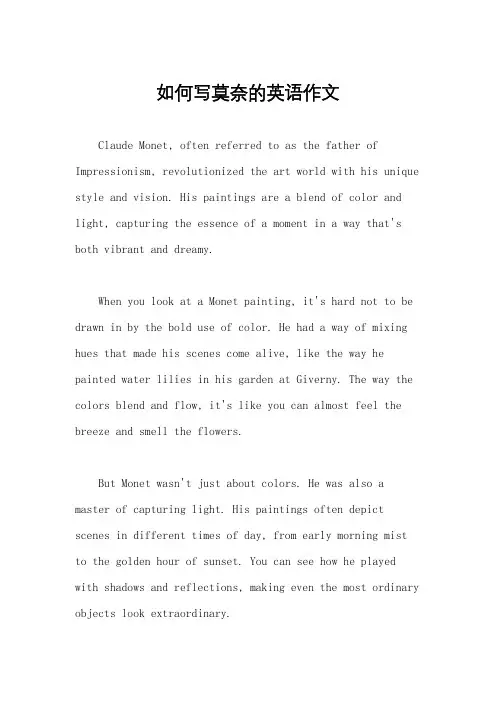
如何写莫奈的英语作文Claude Monet, often referred to as the father of Impressionism, revolutionized the art world with his unique style and vision. His paintings are a blend of color and light, capturing the essence of a moment in a way that's both vibrant and dreamy.When you look at a Monet painting, it's hard not to be drawn in by the bold use of color. He had a way of mixing hues that made his scenes come alive, like the way he painted water lilies in his garden at Giverny. The way the colors blend and flow, it's like you can almost feel the breeze and smell the flowers.But Monet wasn't just about colors. He was also a master of capturing light. His paintings often depict scenes in different times of day, from early morning mist to the golden hour of sunset. You can see how he played with shadows and reflections, making even the most ordinary objects look extraordinary.What's really fascinating about Monet is that he never settled for just one style. He was always experimenting and trying new things. Some of his paintings are so abstract, you almost can't recognize what they're meant to be. But that's what makes him so special. He wasn't afraid to take risks and push the boundaries of art.In conclusion, Monet was a true innov。
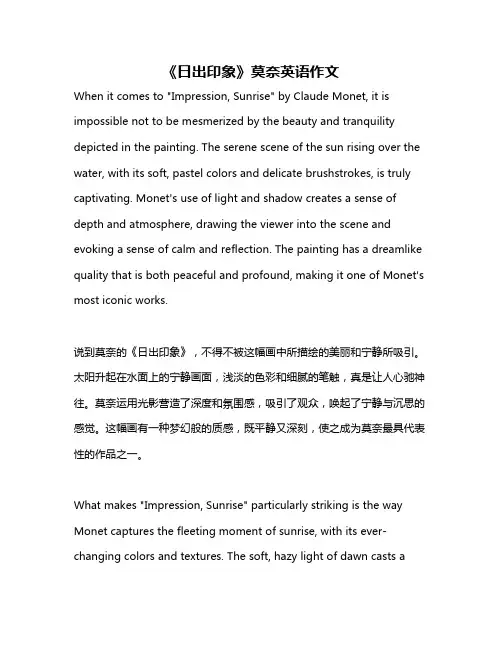
《日出印象》莫奈英语作文When it comes to "Impression, Sunrise" by Claude Monet, it is impossible not to be mesmerized by the beauty and tranquility depicted in the painting. The serene scene of the sun rising over the water, with its soft, pastel colors and delicate brushstrokes, is truly captivating. Monet's use of light and shadow creates a sense of depth and atmosphere, drawing the viewer into the scene and evoking a sense of calm and reflection. The painting has a dreamlike quality that is both peaceful and profound, making it one of Monet's most iconic works.说到莫奈的《日出印象》,不得不被这幅画中所描绘的美丽和宁静所吸引。
太阳升起在水面上的宁静画面,浅淡的色彩和细腻的笔触,真是让人心驰神往。
莫奈运用光影营造了深度和氛围感,吸引了观众,唤起了宁静与沉思的感觉。
这幅画有一种梦幻般的质感,既平静又深刻,使之成为莫奈最具代表性的作品之一。
What makes "Impression, Sunrise" particularly striking is the way Monet captures the fleeting moment of sunrise, with its ever-changing colors and textures. The soft, hazy light of dawn casts aluminous glow over the water, creating a sense of mystery and enchantment. The play of light and shadow on the water surface, along with the reflection of the sun's rays, adds a sense of movement and vitality to the scene. Monet's masterful use of color and light creates a sense of dynamism and energy that is both captivating and ethereal.《日出印象》之所以如此引人注目,是因为莫奈捕捉了日出这一瞬息万变的光影和质感。
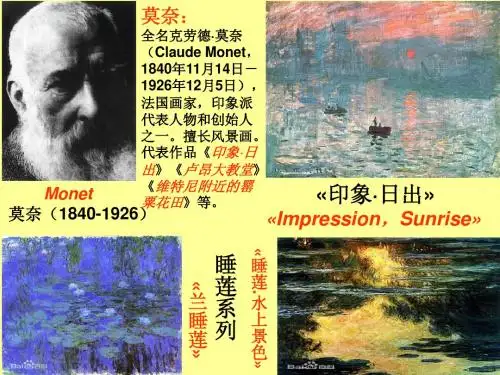
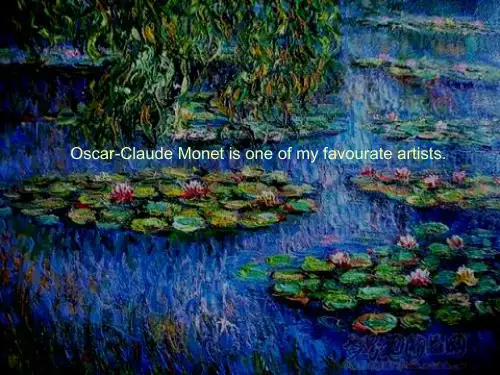
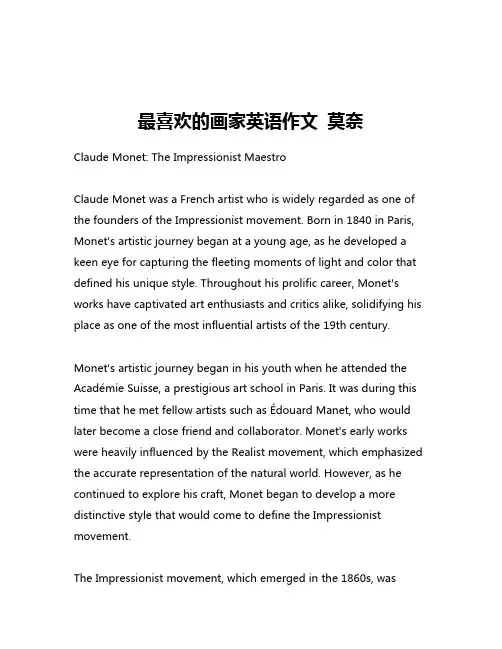
最喜欢的画家英语作文莫奈Claude Monet: The Impressionist MaestroClaude Monet was a French artist who is widely regarded as one of the founders of the Impressionist movement. Born in 1840 in Paris, Monet's artistic journey began at a young age, as he developed a keen eye for capturing the fleeting moments of light and color that defined his unique style. Throughout his prolific career, Monet's works have captivated art enthusiasts and critics alike, solidifying his place as one of the most influential artists of the 19th century.Monet's artistic journey began in his youth when he attended the Académie Suisse, a prestigious art school in Paris. It was during this time that he met fellow artists such as Édouard Manet, who would later become a close friend and collaborator. Monet's early works were heavily influenced by the Realist movement, which emphasized the accurate representation of the natural world. However, as he continued to explore his craft, Monet began to develop a more distinctive style that would come to define the Impressionist movement.The Impressionist movement, which emerged in the 1860s, wascharacterized by a focus on capturing the fleeting effects of light and atmosphere. Monet's paintings, with their vibrant colors and loose brushstrokes, were a departure from the traditional academic style that had dominated the art world for centuries. Instead of meticulously rendering every detail, Monet sought to capture the essence of a scene, using his unique perspective and artistic vision to create works that were both visually stunning and emotionally evocative.One of Monet's most famous works, "Impression, Sunrise," is a prime example of his Impressionist style. Painted in 1872, the work depicts a hazy sunrise over the port of Le Havre in France. The painting's loose brushstrokes and muted colors create a sense of atmosphere and movement, capturing the ephemeral beauty of the moment. The work was met with criticism from the art establishment, who dismissed it as unfinished and lacking in technical skill. However, Monet's unwavering dedication to his craft and his refusal to compromise his vision ultimately led to the recognition and acceptance of Impressionism as a legitimate artistic movement.Throughout his career, Monet continued to explore the themes of light and color, creating a body of work that is unparalleled in its beauty and technical mastery. His series of paintings depicting the water lilies in his garden at Giverny are particularly renowned, showcasing his ability to capture the ever-changing effects of lighton the surface of the water. These works, with their soft, hazy colors and delicate brushstrokes, have become some of the most iconic images in the history of art.Monet's influence on the art world cannot be overstated. His innovative approach to painting, which emphasized the subjective experience of the artist over the objective representation of the subject, paved the way for the development of modern art. Generations of artists have been inspired by Monet's work, and his legacy continues to be celebrated and studied by art enthusiasts around the world.In addition to his artistic achievements, Monet was also a dedicated philanthropist, using his wealth and influence to support various charitable causes. He was particularly passionate about environmental conservation, and his efforts to preserve the natural beauty of his beloved Giverny garden have been widely recognized.Despite the many accolades and honors he received throughout his lifetime, Monet remained humble and dedicated to his craft. He once said, "My life has been nothing but a failure, and all that I have accomplished has been beyond my abilities." This sentiment, however, belies the profound impact that Monet's work has had on the art world and on the lives of countless individuals who have been captivated by his masterful depictions of the natural world.In conclusion, Claude Monet's legacy as one of the most influential artists of the 19th century is undeniable. His Impressionist style, which captured the fleeting beauty of light and color, has inspired generations of artists and continues to captivate art enthusiasts around the world. Whether you are admiring the soft hues of his water lily paintings or marveling at the vibrant brushstrokes of his landscapes, Monet's work stands as a testament to the power of art to transform our understanding of the world around us.。
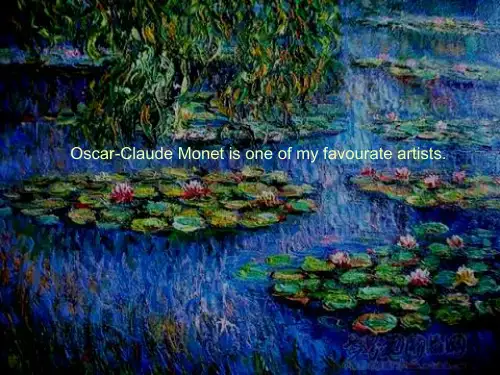
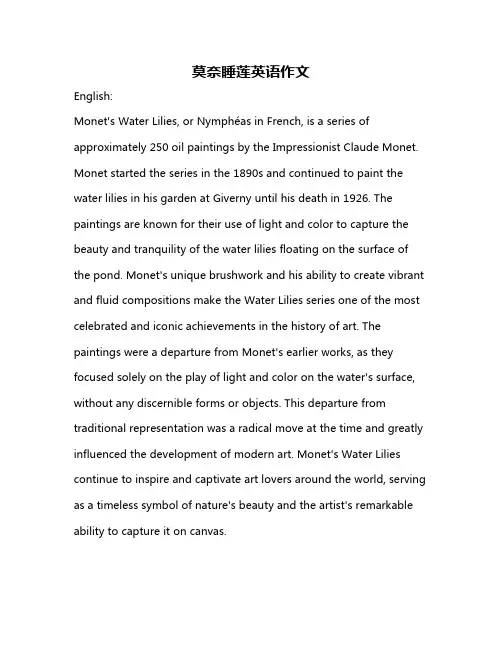
莫奈睡莲英语作文English:Monet's Water Lilies, or Nymphéas in French, is a series of approximately 250 oil paintings by the Impressionist Claude Monet. Monet started the series in the 1890s and continued to paint the water lilies in his garden at Giverny until his death in 1926. The paintings are known for their use of light and color to capture the beauty and tranquility of the water lilies floating on the surface of the pond. Monet's unique brushwork and his ability to create vibrant and fluid compositions make the Water Lilies series one of the most celebrated and iconic achievements in the history of art. The paintings were a departure from Monet's earlier works, as they focused solely on the play of light and color on the water's surface, without any discernible forms or objects. This departure from traditional representation was a radical move at the time and greatly influenced the development of modern art. Monet's Water Lilies continue to inspire and captivate art lovers around the world, serving as a timeless symbol of nature's beauty and the artist's remarkable ability to capture it on canvas.Translated content:莫奈的睡莲,或者法语中的Nymphéas,是印象派画家克劳德·莫奈的一系列油画作品,大约有250幅。

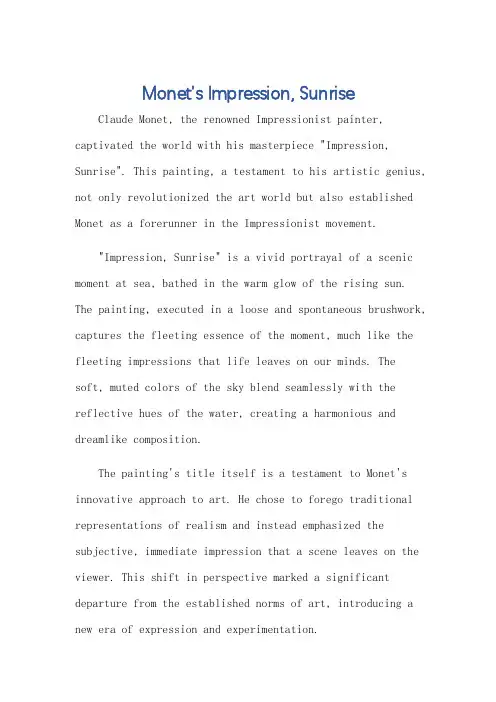
Monet's Impression, SunriseClaude Monet, the renowned Impressionist painter, captivated the world with his masterpiece "Impression, Sunrise". This painting, a testament to his artistic genius, not only revolutionized the art world but also established Monet as a forerunner in the Impressionist movement."Impression, Sunrise" is a vivid portrayal of a scenic moment at sea, bathed in the warm glow of the rising sun. The painting, executed in a loose and spontaneous brushwork, captures the fleeting essence of the moment, much like the fleeting impressions that life leaves on our minds. The soft, muted colors of the sky blend seamlessly with the reflective hues of the water, creating a harmonious and dreamlike composition.The painting's title itself is a testament to Monet's innovative approach to art. He chose to forego traditional representations of realism and instead emphasized the subjective, immediate impression that a scene leaves on the viewer. This shift in perspective marked a significant departure from the established norms of art, introducing a new era of expression and experimentation.Moreover, "Impression, Sunrise" highlights Monet's skillful use of light and color. The play of light across the water's surface and the subtle variations in hue create a dynamic and alive painting that seems to breathe and pulsate with the energy of the natural world. This masterful manipulation of light and color not only enhances the painting's visual impact but also deepens its emotional resonance.The influence of "Impression, Sunrise" on subsequent generations of artists cannot be overstated. It inspired a new wave of painters to experiment with color, light, and form, giving rise to the Impressionist movement and its successors. Monet's innovative approach to painting, emphasized by this masterpiece, continues to inspire and challenge artists today.In conclusion, "Impression, Sunrise" is not only a stunning visual representation of nature's beauty but also a powerful symbol of artistic revolution. It remains a testament to Monet's genius and a cornerstone of Impressionist art, forever changing the way we see and appreciate the world through the lens of art.**莫奈的《日出·印象》**克劳德·莫奈,这位著名的印象派画家,以其杰作《日出·印象》征服了世界。

三一文库()〔描写莫奈和莫奈作品的英语作文〕导语:莫奈一生遗留500件素描,2000多幅油画及2700封信件。
足迹由巴黎大街到地中海岸,从法国到伦敦、威尼斯、挪威,在各地旅行写生,留下无数的作品。
下面是yuwenmi小编为大家整理的优秀英语作文,欢迎阅读与借鉴,谢谢!My IdolMonet, Claude (b. Nov. 14, 1840, Paris, Fr.--d. Dec.5, 1926, Giverny) French painter, initiator, leader,and unswerving advocate of the Impressionist style. Heis regarded as the archetypal Impressionist in that his第1页共4页devotion to the ideals of the movement was unwavering throughout his long career, and it is fitting that oneof his pictures--Impression: Sunrise (Musée Marmottan, Paris; 1872)--gave the group his name. Hisyouth was spent in Le Havre, where he first excelledas a caricaturist but was then converted to landscape painting by his early mentor Boudin, from whom hederived his firm predilection for painting out of doors.In 1859 he studied in Paris at the Atelier Suisse and formed a friendship with Pissarro. After two years' military service in Algiers, he returned to Le Havreand met Jongkind, to whom he said he owed `thedefinitive education of my eye'. He then, in 1862, entered the studio of Gleyre in Paris and there met Renoir, Sisley, and Bazille, with whom he was to formthe nucleus of the Impressionist group. Monet's devotion to painting out of doors is illustrated by the famous story concerning one of his most ambitious early works, Women in the Garden (Musée d'Orsay, Paris; 1866-67). The picture is about 2.5 meters highand to enable him to paint all of it outside he had atrench dug in the garden so that the canvas could be24。

克劳德·莫奈克劳德·莫奈(Claude Monet,1840年11月14日-1926年12月5日),法国画家,印象派代表人物和创始人之一。
莫奈是法国最重要的画家之一,印象派的理论和实践大部份都有他的推广。
莫奈擅长光与影的实验与表现技法。
他最重要的风格是改变了阴影和轮廓线的画法,在莫奈的画作中看不到非常明确的阴影,也看不到突显或平涂式的轮廓线。
人物简介克劳德·莫奈(Claude Monet,1840年11月14日-1926年12月5日),法国画家,印象派代表人物和创始人之一。
莫奈是法国最重要的画家之一,印象派的理论和实践大部份都有他的推广。
莫奈擅长光与影的实验与表现技法。
他最重要的风格是改变了阴影和轮廓线的画法,在莫奈的画作中看不到非常明确的阴影,也看不到突显或平涂式的轮廓线。
除此之外,莫奈对于色彩的运用相当细腻,他用许多相同主题的画作来实验色彩与光完美的表达。
莫奈曾长期探索光色与空气的表现效果,常常在不同的时间和光线下,对同一对象作多幅的描绘,从自然的光色变幻中抒发瞬间的感觉。
印象派运动可以看作是19世纪自然主义倾向的巅峰,也可以看作是现代艺术的起点。
克劳德·莫奈的名字与印象派的历史密切相连。
莫奈对这一艺术环境的形成和他描绘现实的新手法,比其他任何人贡献都多。
这一点是无庸置疑的,印象派的创始人虽说是马奈,但真正使其发扬光大的却是莫奈,因为他对光影之于风景的变化的描绘,已到走火入魔的境地。
人物生平奥斯卡-克洛德·莫奈﹙Oscar-ClaudeMonet,1840年11月14日-1926年12月5日),简称克洛德·莫奈或莫内,台译奥斯卡-克劳德·莫内,大陆传统译莫奈。
法国印象派主要画家,印象派运动领袖人物。
莫内是法国最重要的画家之一,印象派的理论和实践大部份都有他的推广。
莫内擅长光与影的实验与表现技法。
他最重要的风格是改变了阴影和轮廓线的画法,在莫内的画作中看不到非常明确的阴影,也看不到突显或平涂式的轮廓线。
关于描写莫奈和莫奈作品的英语作文Essay 1:Claude Monet, a prominent French painter, is widely regarded as one of the pioneers of Impressionism. Renowned for his exceptional talent in capturing the essence of light and color, Monet's works continue to inspire generations of artists and art enthusiasts worldwide.Monet's paintings often depict landscapes, gardens, and water bodies, such as rivers, ponds, and seas. One of his most famous works is "Water Lilies," a series of paintings that depict the serene beauty of his own water garden in Giverny. These paintings showcase Monet's mastery in capturing the reflection of light on water surfaces and the subtle variations of colors, creating an atmosphere of tranquility and harmony.Another noteworthy aspect of Monet's art is his use of loose brushstrokes and vibrant colors. Unlike the traditional approach of meticulously blending colors on the canvas, Monet applied quick, expressive brushstrokes to capture fleeting moments and impressions. This technique, often termed "en plein air," results in paintings that convey the artist's spontaneous response to his surroundings. It gives his works a sense of movement and vitality, making them appear alive.Furthermore, Monet's fascination with the play of light is evident in his famous series, "Haystacks" and "Rouen Cathedral." In these works, Monet meticulously observed how the changing light influenced the appearance of the same subject at different times ofthe day. Through layers of varying hues and subtle tonal shifts, he successfully conveyed the shifting atmosphere and the transient nature of light itself.In conclusion, Claude Monet's unique style and artistic vision revolutionized the world of art. Through his exceptional ability to capture light and color, he created paintings that evoke emotions and transport viewers into the depicted scenes. Monet's works continue to be admired and cherished, serving as a testament to his genius and his significant contribution to the Impressionist movement.Essay 2:Claude Monet's art is a celebration of nature and the beauty that surrounds us. His paintings transport us to stunning landscapes and captivate us with their vibrant colors, loose brushwork, and delicate depictions of light.One of Monet's most iconic works is "Impression, Sunrise," which gave birth to the term "Impressionism." This piece captures the fleeting moment when the sun rises over the harbor of Le Havre. The brushstrokes are loose and rapid, conveying the artist's impressions and emotions rather than focusing on precise details. The painting showcases Monet's ability to capture the essence of a scene and his dedication to portraying the effects of light on various surfaces, such as the water and the sky.In addition to landscapes, Monet was also fascinated by cityscapes, particularly Paris. His series "Boulevard des Capucines"beautifully portrays the bustling atmosphere of the city, with the play of light transforming ordinary scenes into extraordinary moments. The vibrant colors and dappled patches of sunlight create a sense of movement and energy, reflecting the fast-paced nature of urban life.Furthermore, Monet's exploration of reflections in water is evident in his well-known series "The Houses of Parliament" and "The Japanese Bridge." In these pieces, he skillfully depicts the interplay between the solid structures and their watery reflections. Through his use of broken brushstrokes and a vibrant palette, Monet creates a dreamlike quality, blurring the boundaries between reality and illusion.In conclusion, Claude Monet's art is a testament to his unparalleled skill in capturing the fleeting beauty of nature and the ever-changing effects of light. His unique approach to painting, characterized by loose brushwork and vibrant colors, has had a lasting influence on the art world. Monet's paintings continue to captivate audiences, inviting them to immerse themselves in the wonders of the natural world and the way it can be translated onto canvas.Essay 3:Claude Monet, an influential French painter, is renowned for his groundbreaking art that defied traditional conventions. Known as one of the founders of Impressionism, Monet's works captivate with their depiction of everyday scenes and their keen attention to capturing the play of light and color.One of the hallmarks of Monet's style is his ability to capture the beauty of landscapes. His series "The Poppy Field" showcases his skill in depicting nature's vibrant colors and the texture of flowers swaying in the wind. Through his use of short brushstrokes and contrasting shades, Monet creates a sense of movement and vitality, as if the flowers are in constant motion. This series exemplifies his commitment to portraying the transient nature of the world and the ever-changing effects of light.Furthermore, Monet's fascination with capturing the essence of light is evident in his series "Rouen Cathedral." In these paintings, he explores the same subject, the cathedral, at different times of the day, emphasizing the changing moods and atmospheres created by the shifting light. Through his loose brushwork and deliberate choice of colors, Monet transforms the cathedral's façade into a study of the interplay between light, shadow, and color.Moreover, Monet's interest in water bodies is reflected in his iconic series "Water Lilies" and "The Seine at Giverny." These paintings showcase his ability to capture the reflections and distortions created by water, blurring the line between representation and abstraction. The ephemeral quality of water is beautifully depicted through Monet's loose and suggestive brushstrokes, which convey a sense of movement and the ever-changing nature of the subject.In conclusion, Claude Monet's art is a testament to his extraordinary talent in capturing fleeting moments and the interplay of light and color. His paintings continue to inspire and resonate with viewers worldwide, inviting them to appreciate thebeauty that lies in everyday scenes and the ever-changing world around us. Monet's contribution to the Impressionist movement revolutionized the way art is perceived and continues to be celebrated for its innovation and timeless appeal.。
莫奈日出印象英文简介Claude Monet (November 14, 1840 - December 5, 1926), the French painter, known as the "Impressionist leader", is one of the representatives andfounders of the Impressionist.Monet is one of the most important painters in France, and most of the theory and practice of Impressionism have his promotion. Monet specializes in the experiment and expression of light and shadow. His most important style is to change the shadows and contours of the painting, in the paintings of Monet do not see very clear shadows, can not see the highlight or flat painted contours. The color of light and shadow depicts the greatest feature ofMonet's painting.Oscar-Claude Monet (November 14, 1840 - December 5, 1926), referred to as Claude Monet or Moone, Taiwan translation Oscar Claude Monet, The continent of the traditional translation of Monet. French Impressionist major painter, Impressionist movement leader.teensMonet was born in Paris, when he was 5 years old when the family moved to Normandy Le Havre (LeHavre). His father wanted him to inherit the grocerystore at home, but Monet wanted to be an artist.At the age of 15, his first little celebrity was because of his charcoal comic, and the price for his work was 20 francs per piece. On the beaches of Normandy, he met the artist Eugene Boudin, who later became Monet's mentor and taught him to learn painting. When Monet came to the Louvre in Paris, where he saw many painters imitating the works of famous artists. So, carrying the pigments and tools, he sat next to a window and began to draw what he sawMonet was born in Algeria (1860-1862), and before his seven-year contract expires, Mrs. Lecadre of Monet's monks freed him from the army for the typhoid, and let him go to the university Art courses.art educationBecause of the traditional art education of the university made him awake, in 1862 Monet joined Paris in Charles Gleley (Charles Gleyre) studio. Where he confessed Pierre-Auguste Renoir, Frederic Bazille and Alfred Sisley. Theytogether created a new artistic approach, later known as the Impressionist, that is, in the outdoor and natural light with a strong oil painting.In 1866, he created the "Green Woman" (CamilleDoncieux) model (TheWomanintheGreenDress). Soon after, things were pregnant and gave birth to their first child Jean (Jean).During the Franco-Prussian War (1870-1871), Monet came to the British refuge. Where he studied the work of John Kansi Boer and J.M.W. Turner, whose work inspired Monet's innovation in color research.After returning to France, in 1872 or 1873, Monet created "Impression Sunrise" with a landscape of Le Havre. It was unveiled at the first Impressionist painter in 1874 and is now on display at the MuséeMarmottan-Monet in Paris. According to the title of the painting, art critic Luis Leroya put forward the "impressionist" argument.MarriageIn 1870, Monet married the East and West. In 1873, they moved into a house in the Argenteuil of Seine River. On March 17, 1878, they had another son, Michael. In 1879, Mrs. Monet died of tuberculosis.AliceHoschede decided to help Monet raise his two children. They live in Poissy, but Monet does not like it there. In April 1883, they moved to Giverny on the Upper Normandy region of Eure. He planted a large garden and finished his paintings for the rest of his life. Monet and Hoschede married in 1892.LateIn the eighties and nineties of the nineteenth century, Monet began a series of paintings, that is, in different light and angle to draw the same object. heThe first series of works "Rouen Cathedral" is in different angles and different days of the day to draw. In 1895, the paintings of the cathedrals from 20 different angles were exhibited at the Gurand-Ruel gallery. He also drew a series of straw mats.Monet is very fond of painting bound natural - his garden, his water lily, his pond and his little bridge. He also painted up and down the banks of the Seine.Between 1883 and 1908, Monet painted a lot of landscapes and sea views in the Mediterranean.His wife, Alice, died in 1911 and his son died in 1914.Cataracts allowed Monet to undergo two surgeries in 1923.He died on December 5, 1926, buried in the cemetery of the Giverny church.In 2021, Monet's The Salar and EffectsofSunintheFog sold more than $ 20 million in London.1840 - was born in Paris, France. At the age of 5 moved out of Paris, with family living in Le Havre (LeHavre).1850 years - in the painting was enlightened, in 1859 returned to the birthplace of Paris to learn painting.In the 1860s - after serving military service in Algeria, with a considerable number of well-known painter friends, in France everywherepainting painting.The 1870s - after marriage and marriage, expanded the scope of travel, but also expanded the source of inspiration for painting. The 1870s were an important decade in which he began to promote Impressionism. During the decade, the Impressionists held four joint exhibitions. Moone has participated. 1879 was Monet's sad year, his wife Camille died, leaving the first son of the ageof one and 12-year-old eldest son.1880 - Monet's last participation in the Impressionist exhibition was in 1882, after 1884 he began to travel around the country, visited the London,the United States and other places.1890 - Monet began to focus and continue to water lily theme creation,The 1900s - Monet's vision began to develop problems, but he continued to paint, and still painting water lilies, the more painting the greater.1910 - Monet suffered a second wife died in 1911, 1914 death of the eldest son of the blow, vision is rapidly deteriorating. Ironically, Monet was considered a successful painter, works began by the national collection, and money to build a large studio. He began painting large water lilies murals.1920 's - Monet' s old age continued to create, this time his focus on the Louvre will be on display his water lily works, despite the vision is getting worse, has been close to blind, he painted to December 5, 1926 Died so far.感谢您的阅读,祝您生活愉快。
莫奈英文简介莫奈英文简介克劳德·莫奈,法国画家,被誉为“印象派领导者”,是印象派代表人物和创始人之一。
下面是店铺为你整理的莫奈英文简介,希望对你有用!克劳德·莫奈,简介Claude Monet (November 14, 1840 - December 5, 1926), the French painter, known as the "Impressionist leader", is one of the representatives and founders of the Impressionist.Monet is one of the most important painters in France, and most of the theory and practice of Impressionism have his promotion. Monet specializes in the experiment and expression of light and shadow. His most important style is to change the shadows and contours of the painting, in the paintings of Monet do not see very clear shadows, can not see the highlight or flat painted contours. The color of light and shadow depicts the greatest feature of Monet's painting.克劳德·莫奈,人物生平Oscar-Claude Monet (November 14, 1840 - December 5, 1926), referred to as Claude Monet or Moone, Taiwan translation Oscar Claude Monet, The continent of the traditional translation of Monet. French Impressionist major painter, Impressionist movement leader.teensMonet was born in Paris, when he was 5 years old when the family moved to Normandy Le Havre (LeHavre). His father wanted him to inherit the grocery store at home, but Monet wanted to be an artist.At the age of 15, his first little celebrity was because of hischarcoal comic, and the price for his work was 20 francs per piece. On the beaches of Normandy, he met the artist Eugene Boudin, who later became Monet's mentor and taught him to learn painting. When Monet came to the Louvre in Paris, where he saw many painters imitating the works of famous artists. So, carrying the pigments and tools, he sat next to a window and began to draw what he sawMonet was born in Algeria (1860-1862), and before his seven-year contract expires, Mrs. Lecadre of Monet's monks freed him from the army for the typhoid, and let him go to the university Art courses.art educationBecause of the traditional art education of the university made him awake, in 1862 Monet joined Paris in Charles Gleley (Charles Gleyre) studio. Where he confessed Pierre-Auguste Renoir, Frederic Bazille and Alfred Sisley. They together created a new artistic approach, later known as the Impressionist, that is, in the outdoor and natural light with a strong oil painting.In 1866, he created the "Green Woman" (CamilleDoncieux) model (TheWomanintheGreenDress). Soon after, things were pregnant and gave birth to their first child Jean (Jean).During the Franco-Prussian War (1870-1871), Monet came to the British refuge. Where he studied the work of John Kansi Boer and J.M.W. Turner, whose work inspired Monet's innovation in color research.After returning to France, in 1872 or 1873, Monet created "Impression Sunrise" with a landscape of Le Havre. It was unveiled at the first Impressionist painter in 1874 and is now on display at the MuséeMarmottan-Monet in Paris. According to the title of the painting, art critic Luis Leroya put forward the"impressionist" argument.MarriageIn 1870, Monet married the East and West. In 1873, they moved into a house in the Argenteuil of Seine River. On March 17, 1878, they had another son, Michael. In 1879, Mrs. Monet died of tuberculosis.AliceHoschede decided to help Monet raise his two children. They live in Poissy, but Monet does not like it there. In April 1883, they moved to Giverny on the Upper Normandy region of Eure. He planted a large garden and finished his paintings for the rest of his life. Monet and Hoschede married in 1892.LateIn the eighties and nineties of the nineteenth century, Monet began a series of paintings, that is, in different light and angle to draw the same object. heThe first series of works "Rouen Cathedral" is in different angles and different days of the day to draw. In 1895, the paintings of the cathedrals from 20 different angles were exhibited at the Gurand-Ruel gallery. He also drew a series of straw mats.Monet is very fond of painting bound natural - his garden, his water lily, his pond and his little bridge. He also painted up and down the banks of the Seine.Between 1883 and 1908, Monet painted a lot of landscapes and sea views in the Mediterranean.His wife, Alice, died in 1911 and his son died in 1914.Cataracts allowed Monet to undergo two surgeries in 1923.He died on December 5, 1926, buried in the cemetery of the Giverny church.In 2004, Monet's The Salar and EffectsofSunintheFog soldmore than $ 20 million in London.1840 - was born in Paris, France. At the age of 5 moved out of Paris, with family living in Le Havre (LeHavre).1850 years - in the painting was enlightened, in 1859 returned to the birthplace of Paris to learn painting.In the 1860s - after serving military service in Algeria, with a considerable number of well-known painter friends, in France everywhere painting painting.The 1870s - after marriage and marriage, expanded the scope of travel, but also expanded the source of inspiration for painting. The 1870s were an important decade in which he began to promote Impressionism. During the decade, the Impressionists held four joint exhibitions. Moone has participated. 1879 was Monet's sad year, his wife Camille died, leaving the first son of the age of one and 12-year-old eldest son.1880 - Monet's last participation in the Impressionist exhibition was in 1882, after 1884 he began to travel around the country, visited the London, the United States and other places.1890 - Monet began to focus and continue to water lily theme creation,The 1900s - Monet's vision began to develop problems, but he continued to paint, and still painting water lilies, the more painting the greater.1910 - Monet suffered a second wife died in 1911, 1914 death of the eldest son of the blow, vision is rapidly deteriorating. Ironically, Monet was considered a successful painter, works began by the national collection, and money to build a large studio. He began painting large water lilies murals.1920 's - Monet' s old age continued to create, this time his focus on the Louvre will be on display his water lily works, despitethe vision is getting worse, has been close to blind, he painted to December 5, 1926 Died so far.。
Monet's Masterpieces: A Journey ThroughImpressionismClaude Monet, a pioneering figure in the realm of Impressionism, revolutionized the art world with his unique and innovative style. His paintings, often described as impressionistic, captured the essence of light and color, blurring the boundaries between representation and abstraction. Through his lens, the viewer is transported to a world where light dances across surfaces, creating a sense of movement and vitality.Monet's masterpiece, "Impression, Sunrise," is a testament to his mastery of light and color. Painted in 1872, this painting depicts the French port town of Le Havre at sunrise. The canvas is awash with soft, muted colors, with pinks and oranges bleeding into each other, creating a sense of warmth and tranquility. The lack of sharp details and the emphasis on light and shadow give the painting a dreamlike quality, as if the viewer is witnessing the world through a veil of morning mist.Another notable work is "Water Lilies," a series of paintings depicting the artist's garden at Giverny. Thesepaintings feature vibrant greens and blues, accentuated by the sun's reflection on the water's surface. The flowers and leaves are rendered in such a way that they appear to be floating in air, their forms blurred and merged with the surrounding water and sky. This blurring effect creates a sense of infinity, as if the viewer is peering into an endless world of natural beauty.Monet's use of color and light was not just aesthetic; it was also a political statement. His rejection of traditional painting techniques and his emphasis on capturing the fleeting moments of nature were a direct challenge to the stodgy art establishment of his time. His works were often criticized for their lack of detail and realism, but he stubbornly stuck to his vision, creating a new art form that would influence generations of artists. In addition to his masterpieces, Monet's life and personality are also fascinating. He was a passionate and dedicated artist, often spending hours painting in his garden or along the banks of the Seine River. His dedication to his craft and his unique artistic vision arewhat make him one of the most beloved and respected artists in history.Monet's works not only offer aesthetic pleasure butalso provide insights into the artist's life and the world he inhabited. His paintings are not just representations of nature; they are expressions of his feelings and emotions. Through his lens, we see not just the beauty of nature but also the beauty of life itself.In conclusion, Monet's masterpieces are not just paintings; they are testaments to the artist's vision and talent. They offer a unique perspective on the world, one that is both beautiful and profound. Through his works, we are able to experience the world in a new and different way, one that is both感官上的愉悦和精神上的满足。